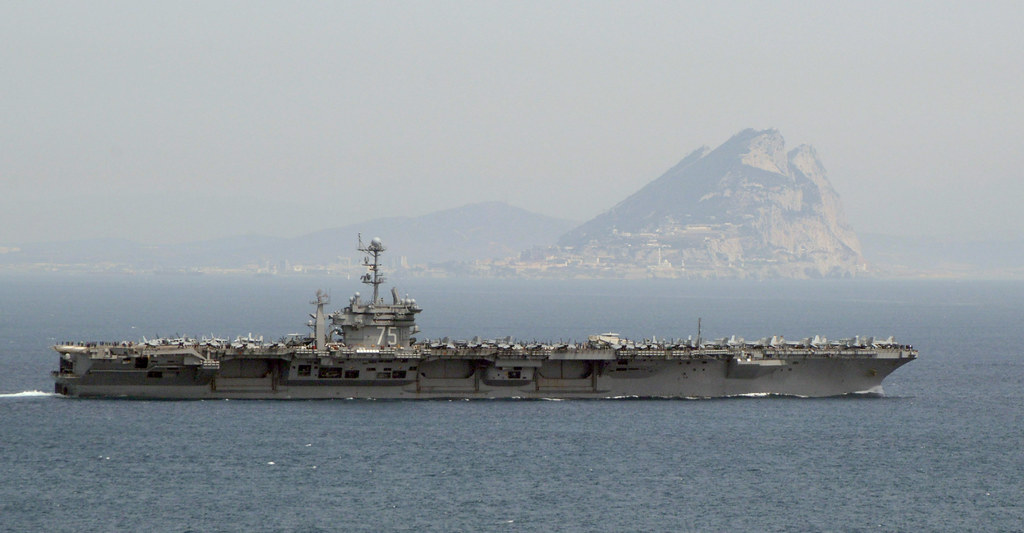
L’art de la guerre
Flotte USA avec 1.000 missiles en Méditerranée
Manlio Dinucci
Le porte-avions USA Harry S. Truman, parti de la plus grande base navale du monde à Norfolk en Virginie, est entré en Méditerranée avec son groupe d’attaque.
Celui-ci est composé du croiseur lance-missiles Normandy et des torpilleurs lance-missiles Arleigh Burke, Bulkeley, Forrest Sherman et Farragut, plus sous peu deux autres, le Jason Dunham et The Sullivans. Est rattachée au groupe d’attaque du Truman la frégate allemande Hessen.
La flotte, avec plus de 8.000 militaires à bord, a une énorme puissance de feu. Le Truman - super-porte-avions long de plus de 300 mètres, doté de deux réacteurs nucléaires- peut lancer à l’attaque, par vagues successives, 90 chasseurs et hélicoptères. Son groupe d’attaque, intégré par 4 chasseurs torpilleurs déjà en Méditerranée et par plusieurs sous-marins, peut lancer plus de 1.000 missiles de croisière.
Ainsi se trouvent notablement potentialisées les Forces navales USA pour l’Europe et l’Afrique, dont le quartier général est à Naples-Capodichino et la base de la Sixième Flotte à Gaeta, sous les ordres du même amiral (actuellement James Foggo) qui commande la Force Conjointe Alliée à Lago Patria (Naples).
Ceci participe de la montée en puissance générale des forces étasuniennes en Europe, sous les ordres du même général (actuellement Curtis Scaparrotti) qui recouvre la charge de Commandant Suprême Allié en Europe.
Dans une audition au Congrès, Scaparrotti explique la raison de cette montée en puissance. Ce qu’il présente est un véritable scénario de guerre : il accuse la Russie de mener “une campagne de déstabilisation pour modifier l’ordre international, broyer l’Otan et miner le leadership USA dans le monde entier”. En Europe, après “l’annexion illégale de la Crimée par la Russie et sa déstabilisation de l’Ukraine orientale”, les États-Unis, qui déploient plus de 60.000 militaires dans des pays européens de l’OTAN/NATO, ont renforcé ce déploiement par une brigade blindée et une brigade aérienne de combat, et ont constitué des dépôts pré-positionnés d’armements pour l’envoi d’autres brigades blindées. Ils ont en même temps redoublé le déploiement de leurs navires de guerre en Mer Noire.
Pour accroître leurs forces en Europe les États-Unis ont dépensé en cinq années plus de 16 milliards de dollars, en poussant simultanément leurs alliés européens à augmenter leur propre dépense militaire de 46 milliards de dollars en trois ans pour renforcer le déploiement OTAN/NATO contre la Russie.
Ceci entre dans la stratégie lancée par Washington en 2014 avec le putsch de Place Maïdan et l’attaque successive contre les Russes d’Ukraine : faire de l’Europe la première ligne d’une nouvelle guerre froide pour renforcer l’influence étasunienne sur les alliés et faire obstacle à la coopération eurasiatique.
Les ministres des Affaires étrangères de l’OTAN/NATO ont réaffirmé le 27 avril leur consensus, en préparant une extension ultérieure de l’OTAN/NATO à l’Est contre la Russie par l’entrée de Bosnie-Herzégovine, Macédoine, Géorgie et Ukraine.
Cette stratégie requiert une préparation adéquate de l’opinion publique. À cet effet Scaparrotti accuse la Russie d’”utiliser la provocation politique, diffuser la désinformation et miner les institutions démocratiques” y compris en Italie. Il annonce ensuite que “les USA et l’OTAN/NATO combattent la désinformation russe avec une information véridique et transparente”. Dans leur sillage la Commission européenne annonce une série de mesures contre les fake news, en accusant la Russie d’utiliser “la désinformation dans sa stratégie de guerre”.
On peut s’attendre à ce que l’OTAN/NATO et l’UE censurent ce qui nous publions ici en décrétant que la flotte USA en Méditerranée est une fake news diffusée par la Russie dans sa “stratégie de guerre”.
Edition de mardi 1er mai 2018 de Il manifesto


